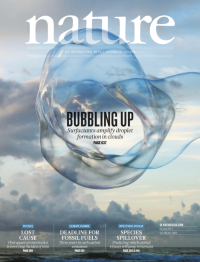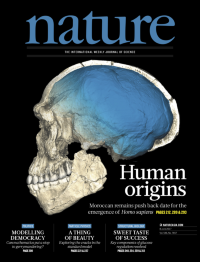Volume 546
-
No. 7660 29 June 2017
Droplets form in atmospheric clouds through heterogeneous nucleation on aerosol particles that act as cloud condensation nuclei. Spontaneous activation of these nuclei depends on the interplay between two factors: the Raoult effect and the Kelvin effect. In the Raoult effect, activation potential increases as solute concentration rises or as water activation decreases. In the Kelvin effect, activation potential decreases as droplet size shrinks, and increases as surface tension is lowered. It is generally thought that any lowering of particle surface tension induced by organic molecules would be cancelled out by a simultaneous reduction in the Raoult effect with little overall effect on cloud-droplet activation. However, in this issue, Colin OâDowd and his colleagues show that in the atmosphere, surfactant molecules can lower surface tension in such a way that its effect on water uptake prevails over any changes in the Raoult effect, leading to a large increase in the concentration of cloud droplets. The authors suggest that this should have implications for the representation of cloud formation processes in climate models. Cover image: michaeldunlap.net
-
No. 7659 22 June 2017
The cover shows an artistâs impression of the Jupiter-like gas giant KELT-9b (bottom) in orbit around the massive star KELT-9. In this issue, Scott Gaudi, Keivan Stassun and their colleagues report the discovery of KELT-9b and reveal it to be one of the hottest exoplanets so far identified. Its dayside surface temperature is about 4,600 K â hotter than most stars, and hot enough to vaporize its atmosphere and to dissociate any molecules into their constituent atoms. The planet is nearly three times more massive than Jupiter but only half as dense. It takes roughly 1.5 days to orbit its host star, and, because it is constantly being blasted with high levels of ultraviolet radiation, it may be shedding a tail of material much like a comet. The rate of ablation may be sufficient for KELT-9b to evaporate completely before its host star reaches the end of its life â assuming that the star doesnât grow and engulf the planet first. As only the seventh âhot Jupiterâ to be found orbiting a hot A-type star, KELT-9b should help deepen understanding of planetary systems around massive stars, the authors say. Cover image: NASA/JPL-Caltech/R. Hurt (IPAC)
-
No. 7658 15 June 2017
Three papers in this issue provide a plethora of new genome sequences for the Zika virus and offer insights into its genetic epidemiology. On page 401, Kristian Anderson and his colleagues reveal 39 new genome sequences obtained from infected patients and Aedes aegypti mosquitoes. Using phylogenetic analysis they conclude that the virus has been introduced to Florida on multiple separate occasions and that most of these events were linked to travel from the Caribbean. Their work also suggests that Zika transmission chains in Florida are unlikely to persist, indicating that future outbreaks would depend on transmission dynamics in the Americas. On page 406, Nuno Faria and his colleagues provide 54 new virus genomes, mostly from northeast Brazil, several sequenced in real time using portable DNA sequencers and a mobile genomics laboratory. Using these and other available sequences they trace the spatial origins and spread of the virus in Brazil and the Americas, revealing that northeast Brazil played a crucial role in establishing the epidemic and the spread of the virus on the continent. And on page 411, Bronwyn MacInnis and her colleagues analyse 110 Zika virus genomes derived from clinical and mosquito samples from ten countries and territories. Their work affirms the rapid expansion of the epidemic within Brazil and multiple introductions to other geographical regions. They also describe the ongoing evolution of the virus and look at how the accumulation of mutations might affect the future performance of diagnostic tests. Cover image: Jasiek Krzysztofiak/Nature
-
No. 7657 8 June 2017
The exact place and time of Homo sapiensâ emergence remains obscure because the fossil record is scanty and the chronological age of many key specimens remains uncertain. In this weekâs issue, Jean-Jacques Hublin and his colleagues describe new human fossils from Jebel Irhoud in Morocco; their work is accompanied by a separate report on the dating of the fossils by Shannon McPherron and his colleagues. Together they report remains of at least five individuals in the layer dating back 300,000â350,000 years. They identify numerous features, including a facial, mandibular and dental morphology, that align the material with early or recent modern humans. They also identify more primitive neurocranial and endocranial morphology. Collectively, the researchers believe that the remains of the Jebel Irhoud hominins can be assigned to the earliest evolutionary phase of Homo sapiens. Image: Philipp Gunz, MPI EVA Leipzig (License: CC-BY-SA 2.0)
-
No. 7656 1 June 2017
The diversity of life on Earth is breathtaking â but it is also under serious threat. Potentially beneficial relationships, such as that between the zebra and red-billed oxpecker shown on the cover, abound, but other, potently destructive relationships are challenging species, habitats and ecosystems as never before. In this weekâs issue, Nature explores some of the key themes in biodiversity and conservation. The Insight delves deeply into both the processes that gave rise to the rich variety of life and the accelerating rate at which this diversity is being curtailed. Crucially, it also explores ways to mitigate and protect ecosystems as well as the myriad benefits of such conservation efforts. Elsewhere, a News Feature reveals how thinking about functional units in ecosystems can be more useful than simply cataloguing species. Two Comment articles tackle the issues of land access and the parlous state of taxonomy. And two Letters consider how diversity drives ecosystem functioning and the scope for disproportionate gains in biodiversity from relatively small expansions in protected areas. There are clear gains to be made by shrewd policymaking and local engagement â but the clock is ticking. Cover image: Richard Du Toit/Minden/NGC





